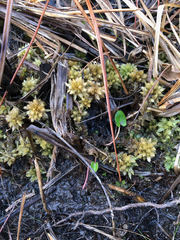Sphagnum perichaetiale
|
|
|
|
Family: Sphagnaceae
|
Plants ± moderate-sized, compact and stiff-stemmed; forming dense to somewhat loose low cushions in often seasonally dry depressions. Stems brown; superficial cortical layer with spiral reinforcing fibrils faint to obvious, 1-3 pores per cell, comb-fibrils lacking on interior wall. Stem leaves to 1.1 × 0.7 mm, commonly hemiisophyllous; hyaline cells non-ornamented, mostly 1-2-septate. Branches short and blunt at distal end, leaves loosely spreading. Branch fascicles with 2 spreading and 1-2 pendent branches. Branch stems with hyaline cells non-ornamented, no or weak funnel-like projection of end walls of cortical cells, cortical cells with one large pore per cell on superficial wall. Branch leaves ovate, to 2.2 × 1.1 mm; ovate, hyaline cells non-ornamented, on proximal half of convex surface with small ringed pores or pseudopores in groups of three where the corners join and pseudopores along the commissures; chlorophyllous cells narrowly rectangular, lenticular to narrowly trapezoidal in transverse section; exposed equally on both surfaces or more broadly on concave surface; end walls not thickened. Sexual condition dioicous. Capsule with numerous pseudostomata. Spores 25-39 µm; surface smooth to irregularly and finely papillose; indistinct Y-mark on distal surface; proximal laesura more than 0.6 spore radius. Capsules common, mature late spring to early summer. Mostly ruderal, wet depressions in sandy substrates, often in areas recently burned, also low to moderate-sized hummocks in Chamaecyparis swamps; low to high elevations; Ala., Del., Fla., Ga., La., Md., Miss., N.J., N.C., S.C., Tex., Va.; South America; se Asia; s Africa; Pacific Islands (New Zealand). The compact growth form in thin but dense mats and occurrence in often dessication-prone sites distinguishes Sphagnum perichaetiale from any other species of sect. Sphagnum. The often quite stiffly spreading branch leaves give it a strong resemblance to S. compactum, but the latter´s small triangular stem leaves will readily distinguish that species. The branch leaf hyaline cells of S. perichaetiale have only a few pores on their convex surface, and they are typically small, thickened, and grouped in 3s where the cell corners meet. Similar species in sect. Sphagnum have more pores along the commissures, and they are more elliptical and not thickened. The often hemiisophyllous stem leaves are also diagnostic of S. perichaetiale within the section.
|






















